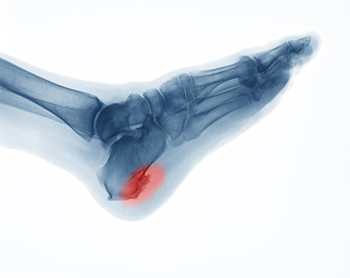
Two conditions that involve the growth of bone spurs in the heel are heel spur syndrome and insertional Achilles tendonitis. Calcaneal (heel) spurs commonly develop in people who have plantar fasciitis, an inflammation of the band of tissue that runs along the sole of the foot. Bone spurs sprout as a way of protecting the bottom of the heel. Common causes are strained foot muscles and ligaments, and over-stretching the plantar fascia. Other factors in heel spur development are age, obesity, and osteoarthritis. Fortunately, most heel spurs are not painful. Insertional Achilles tendonitis affects the part of the heel that connects to the leg bone. The spur develops around the tendon and irritates it, causing pain. The inflamed portion of the tendon can then calcify. Insertional Achilles tendonitis usually develops gradually, aided by repetitive running and jumping and the aging process. If you have heel pain, it may be a good idea to consult a podiatrist to conduct an exam and provide treatment based on the diagnosis.
Heel spurs can be incredibly painful and sometimes may make you unable to participate in physical activities. To get medical care for your heel spurs, contact one of our podiatrists from Family Foot Care of Long Island. Our doctors will do everything possible to treat your condition.
Heels Spurs
Heel spurs are formed by calcium deposits on the back of the foot where the heel is. This can also be caused by small fragments of bone breaking off one section of the foot, attaching onto the back of the foot. Heel spurs can also be bone growth on the back of the foot and may grow in the direction of the arch of the foot.
Older individuals usually suffer from heel spurs and pain sometimes intensifies with age. One of the main condition's spurs are related to is plantar fasciitis.
Pain
The pain associated with spurs is often because of weight placed on the feet. When someone is walking, their entire weight is concentrated on the feet. Bone spurs then have the tendency to affect other bones and tissues around the foot. As the pain continues, the feet will become tender and sensitive over time.
Treatments
There are many ways to treat heel spurs. If one is suffering from heel spurs in conjunction with pain, there are several methods for healing. Medication, surgery, and herbal care are some options.
If you have any questions feel free to contact our office located in Port Jefferson Station, NY . We offer the latest in diagnostic and treatment technology to meet your needs.
